Top 11 IT Onboarding Software for 2026: Features, Integrations, and Buyer's Guide
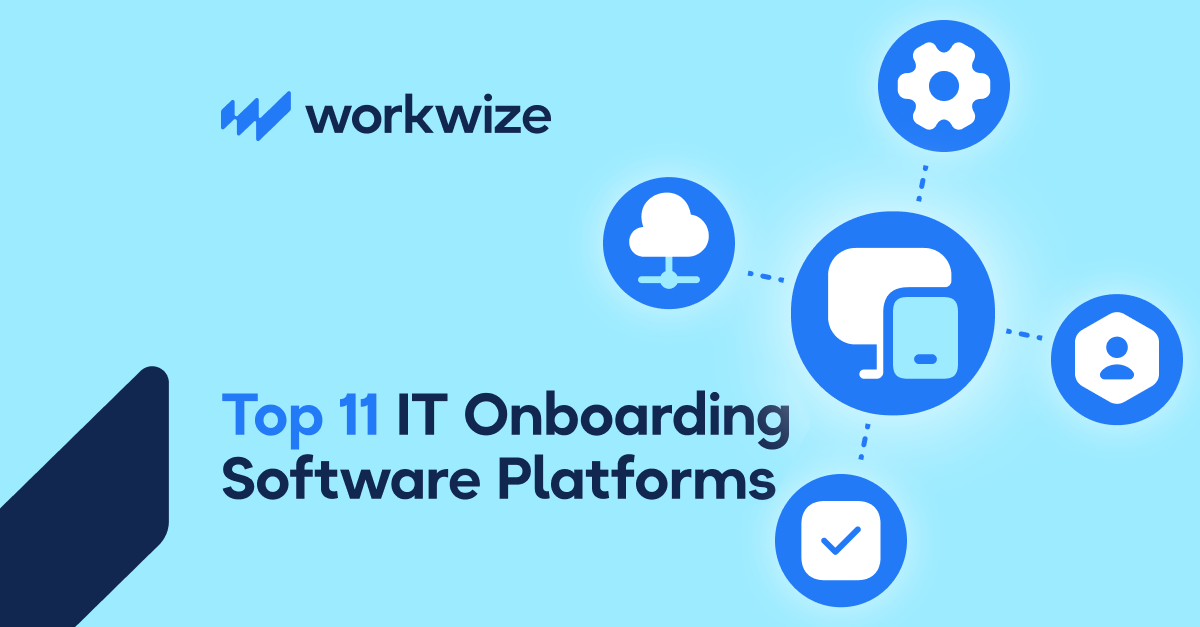
Your new hire doesn’t care about your tech stack. They care about starting fast, without begging for passwords, Wi-Fi, or a laptop that still smells like shipping foam.
And that’s why IT onboarding matters!
Without a proper onboarding flow, people wait for accounts, chase licenses, and file tickets on day 1.
Security also takes a hit when you skip MFA or ship an unpatched device. And audits get messy because no one can show who got what, when.
In fact, only 12% of employees say their company does a great job with onboarding, according to Gallup.
The good news is that you can beat those odds. With the right tools and processes, you can join the small group that nails day one and keeps people around.
Today, let’s focus on the tools part…
TL;DR:
- IT onboarding depends a lot on the processes and tools used. Inefficient processes lead to bad initial experiences and, in turn, attrition.
- Not every onboarding software is the same; some prioritize the HR side of things, while some focus on device and identity management.
- For the best results, you need a platform that either connects HR and IT processes or combines them in the same platform.
- All of our picks reduce departmental back and forth, to varying degrees, and some even act as both the HRIS and ITSM system in one.
- Always test the tool on a small group before implementing it in your onboarding workflow.
What is IT Onboarding Software?
IT onboarding software is a type of platform that helps you set up new employees with all the technology they need to start working smoothly and securely.
Instead of HR and IT teams manually handling things like account creation, device setup, and app access, the software automates the process.
The building blocks of IT onboarding software are
- Identity and access management: The process of creating accounts, adding the user to groups, and setting up SSO and MFA.
- Device provisioning: Enrolling the laptop or phone in MDM, applying security baselines, and configuring zero-touch so the device configures itself on first power-on
- SaaS or app management: This can include custom or third-party solutions developed through software development as a service to ensure bespoke onboarding tools are automatically provisioned for new hires — from assigning licenses and auto-provisioning apps to cleanly removing access during offboarding.
Effective onboarding software reduces the time it takes for employees to become productive, minimizes mistakes, and lowers early employee attrition.
Below, I list my top picks for the best IT onboarding software in 2025. I selected each pick after watching demos, reading reviews, and trialing the tools.
Top 11 IT Onboarding Software Platforms for 2026
Here's the juicy bit: my picks for the best IT onboarding software platforms.
|
Tool |
IT Onboarding Features |
Limitations |
|
Workwize |
End-to-end hardware lifecycle: procurement → delivery → retrieval → disposal. Global reach (100+ countries, 10k+ products). 5–7 day shipping. MDM/HRIS/ITSM integrations trigger automatic Day-1 shipments. Centralized asset tracking. Automated offboarding workflows. |
Not an MDM itself; relies on integrations (Jamf, Kandji, Intune, etc.) for software provisioning. |
|
Jamf Pro |
Apple-only MDM. Zero-touch deployment via Apple Business Manager. PreStage profiles push apps, configs, security. Smart Groups keep devices updated. Self Service app portal reduces tickets. Strong compliance/security. |
Apple-only; no logistics (ordering, shipping, retrieval). Learning curve. Extra cost for Protect/Connect modules. |
|
Kandji |
Apple-only MDM + endpoint security. Auto Apps library with always-updated software. Liftoff workflow for branded onboarding. Guided setup workflows. Automated patching, compliance, and reporting. |
Customization limited vs. Jamf (heavier reliance on templates). Endpoint security not bundled. Password sync issues. Pricing not public. Doesn’t handle logistics (ordering, shipping, recycling). |
|
VMware Workspace ONE |
Multi-OS (Windows, macOS, Android, iOS, XR). Zero-touch provisioning (Autopilot, ADE, Android Zero-Touch). Token-based authentication onboarding. Unified app catalog with SSO. Conditional access + lifecycle controls. |
Setup/configuration can be complex. Steeper learning curve. Better suited for large enterprises than SMEs. |
|
Allwhere |
Remote onboarding hub for stipends, perks, and home-office gear. Employees self-serve from budgets/kits. Handles delivery, storage, retrieval. Emphasizes culture and flexibility. |
Not a full IT lifecycle tool. No MDM integration, software provisioning, or deep compliance. Offboarding and secure disposal require extra workflows. |
|
JumpCloud |
Identity + access + device management in one. Automates onboarding from HRIS → groups, app accounts, baseline security policies. Cross-OS support (Windows, macOS, Linux, iOS, Android). Cloud directory, SSO, MFA built-in. |
Shallower Apple-specific workflows than Jamf/Kandji. Reporting gaps for larger fleets. Doesn’t cover logistics (ordering, shipping, retrievals). |
|
Rippling (IT Cloud) |
Unified HR + IT onboarding. Device shipping, setup, inventory management built into HR workflow. Preconfigured devices with apps/security. Automated offboarding with return boxes. Finance integration included. |
Global warehouse details/delivery SLAs not transparent. Logistics scope narrower than Workwize’s 100+ warehouses and 5–7 day delivery. Broader HR/finance focus may dilute IT lifecycle depth. |
|
OneLogin |
Identity-led onboarding. Automates provisioning of accounts and app access (6,000+ pre-integrated apps). SSO + MFA. Role-based rules. Sync with directories like AD, Workday. |
Doesn’t handle hardware, shipping, or device management. Occasional outages/slower support noted. Focused only on access/authentication. |
|
Firstbase |
Global procurement, deployment, retrieval of hardware. Self-service portal for employees (choose from pre-approved catalog). Enboarder integration adds personalized onboarding messages, team intros, pulse checks. Lifecycle coverage up to retrieval. |
Device deployment tied to available inventory pool (no individual asset selection). Smaller global logistics footprint vs. Workwize (no guaranteed 5–7 day delivery, fewer warehouses). |
|
Freshservice (ITSM) |
IT service desk + onboarding automation. Self-service portal for new hires to request devices/software. No-code workflow automation routes approvals/asset assignments. Asset tracking across lifecycle. Knowledge base + omnichannel support. |
Limited workflow depth for very large/complex onboarding. ITSM-first platform, less focus on logistics or hardware lifecycle. |
|
Jira Service Management (Atlassian) |
Centralized portal for onboarding requests (hardware, software, permissions). Configurable workflows for approvals and provisioning. Strong collaboration across IT, HR, dev teams. Asset/configuration management. SLA tracking for onboarding. |
Can feel complex for small orgs. No hardware procurement/shipping. Best for teams already in the Atlassian ecosystem. |
1. Workwize
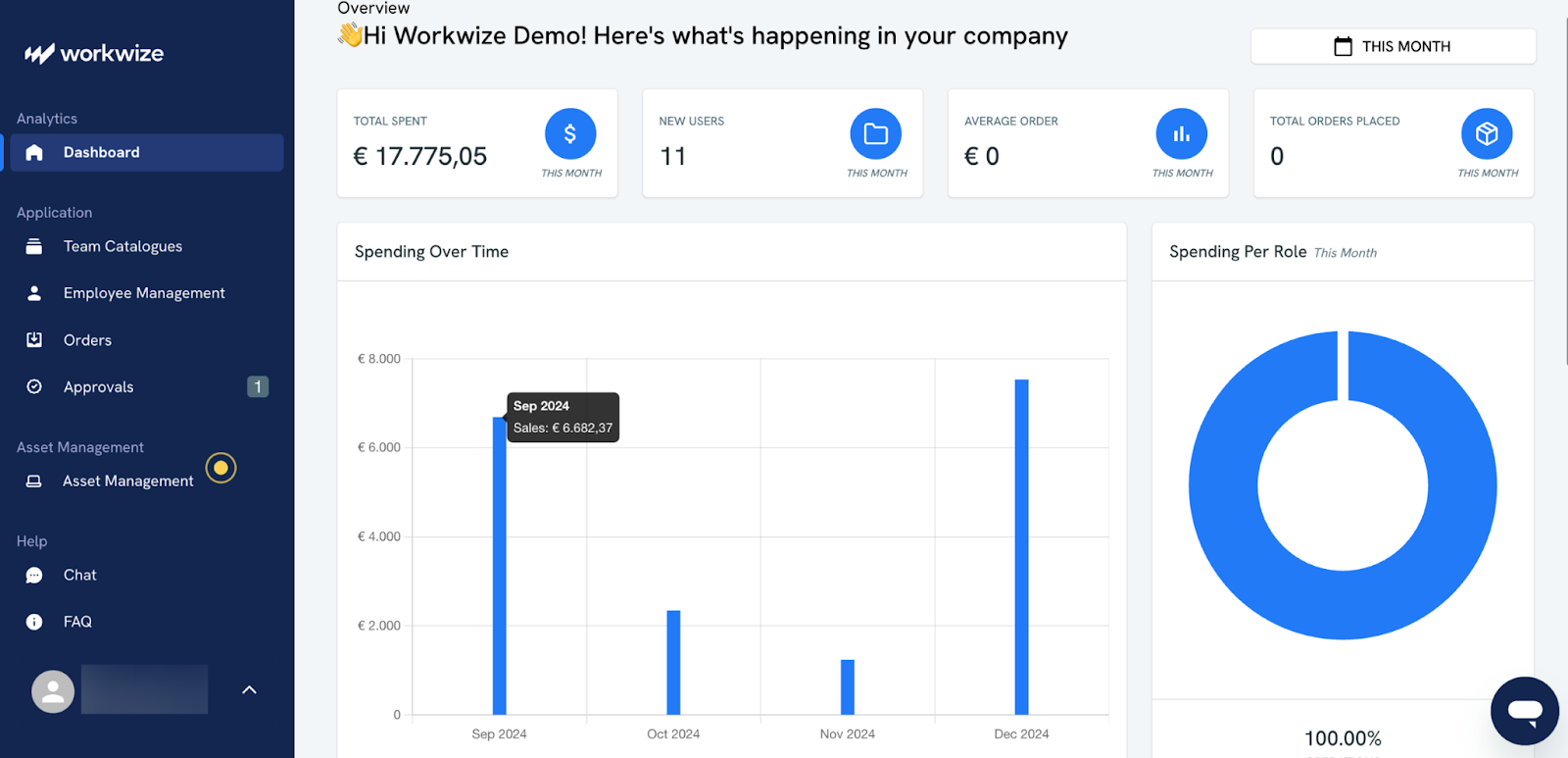
Via Workwize
Managing employee hardware is one of those tasks that sounds simple until you’ve lived through it. Ordering laptops for new hires, making sure they’re preloaded with the right tools, chasing down returns when someone leaves, and trying to keep spreadsheets up to date—it eats up time and creates stress. Workwize exists to make all of that go away.
Workwize is an IT hardware lifecycle management platform that lets you manage your company's hardware from procurement to retirement.
Unlike many other platforms that only handle provisioning or stop at shipping, Workwize covers the entire hardware lifecycle end to end: procurement, delivery, retrieval, and even responsible disposal.
For IT onboarding, the main advantage is simplicity. You can assign devices directly from the dashboard, preconfigure them through integrations with MDM tools like Jamf or Kandji, and have them shipped straight to the employee’s doorstep.
But here’s what really sets it apart:
👉Workwize offers global reach from day one.
Workwize connects you to a supplier network that spans 100+ countries, with an extensive catalog of 10,000+ ready-to-order products. Whether you’re hiring in Berlin, Bangalore, or Boston, the laptop arrives on time without IT meddling with several vendors or losing time discussing rates.
👉You get predictable, upfront logistics
With Workwize, your delivery dates are never a mystery. You can track shipments, get updates, and trust that your new hire’s laptop will land at their doorstep exactly when you promised.
👉You can connect your people systems to automate onboarding.
Workwize plugs into 100+ HRIS, MDM, and ITSM systems. That means when HR enters a new hire into your HRIS, it automatically triggers the Day-1 shipment of their preconfigured device—no manual coordination needed.
The result?
Employees receive a smooth first-day experience: the laptop arrives on time, preloaded with the correct software, and IT doesn’t have to manage shipping, inventory spreadsheets, or FedEx labels.
Offboarding is just as seamless, with automated return workflows that ensure devices are wiped, recovered, and recycled or reassigned.
For organizations hiring globally, it’s one of the few platforms that brings hardware, logistics, and compliance into the same onboarding flow.
Best features
- Automated device provisioning: Ship pre-configured laptops (including high-spec devices) and accessories directly to new hires, no matter their location.
- Centralized asset management: Track every device from procurement to retirement in one system, so IT always knows what’s in use. View details like
- Seamless HR/IT integration: Connect with your HR systems so hardware requests are triggered automatically as soon as a new hire appears on the system.
- Global vendor network: Order and deliver devices worldwide through a single platform from a global network of 100+ suppliers, avoiding the hassle of managing local suppliers.
- Offboarding and recovery: Automate device retrieval and secure data wiping when employees leave, reducing risk and keeping hardware in circulation.
Ratings and reviews
Pricing
Offers three pricing tiers:
- Basic: Essential tools for streamlined device management. Includes delivery in 3 regions, asset tracking, SSO, HRIS + MDM integration, and repair workflows.
- Professional (Most popular): Automation and logistics for scaling teams. Adds auto-deployment, offboarding, restocking, and expands coverage to 5 regions.
- Enterprise: Full control for global IT operations. Includes unlimited regions, SCIM, API access, sustainability tools, and tailored support.
2. Jamf Pro
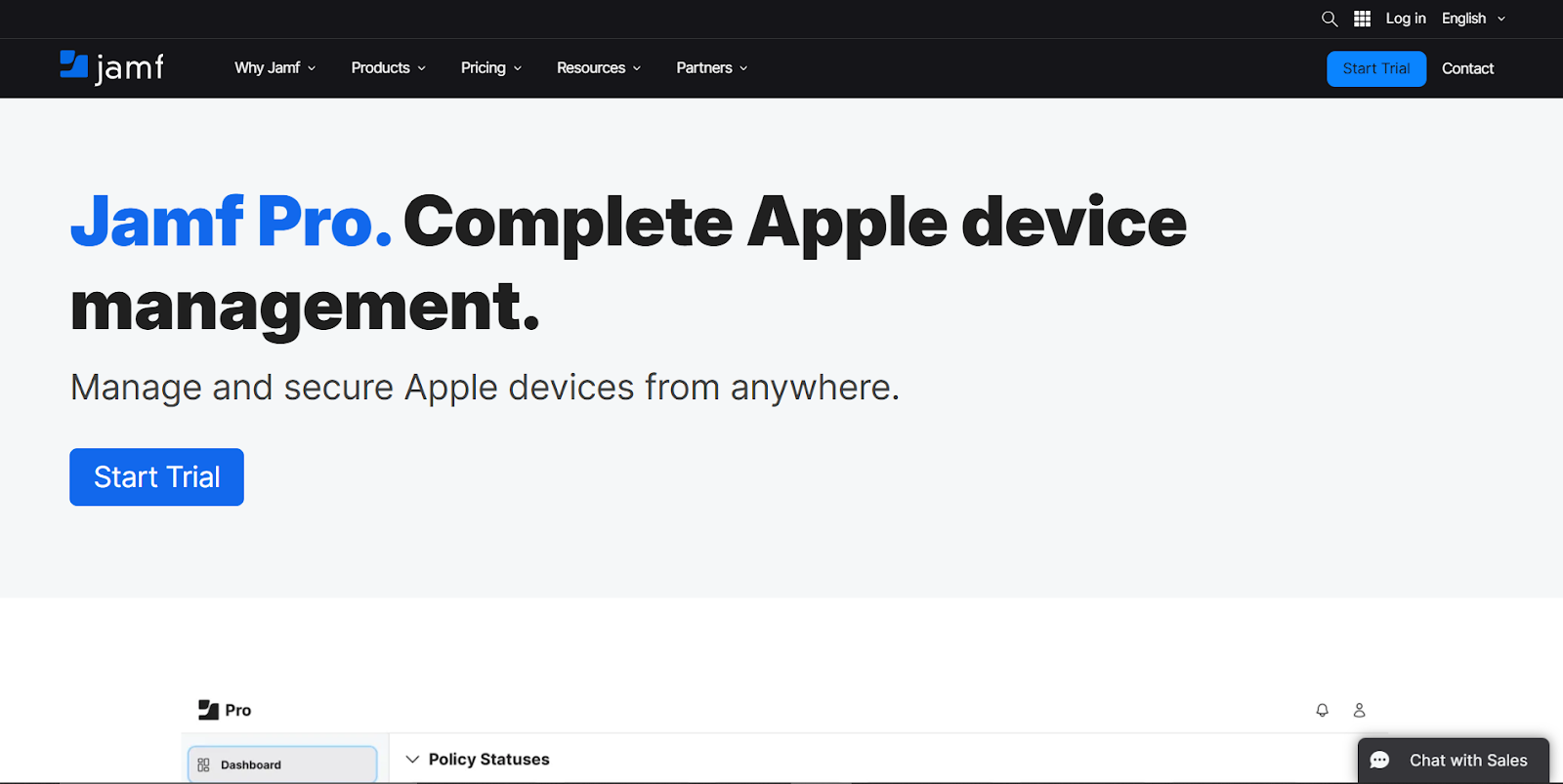
Via Jamf Pro
Jamf Pro is an Apple device management platform for enterprises.
It provides an MDM, inventory, security baselines, and app lifecycle management for macOS, iOS, iPadOS, Apple TV, and now visionOS, making it ideal to provision new hires with Apple hardware.
Using Apple Business Manager, Jamf takes care of enrollment the instant a Mac, iPad, or iPhone is switched on. New hires don’t wait around—they log in and get started on day one.
The setup happens behind the scenes. A PreStage profile pushes down the correct configurations, apps, and security settings automatically. After that, Smart Groups step in to keep everything current, applying policy changes as they happen without IT needing to touch the device
Watching the Jamf demos, what stood out is how Apple-focused it really is. It does not feel like a generic MDM; it is purpose-built for Macs, iPads, and iPhones.
The Self Service portal is a nice touch too, giving employees an approved app catalog that keeps support tickets low. Combine that with zero-touch provisioning, and remote onboarding looks a lot smoother.
Security feels solid as well, with encryption, patching, and compliance checks running quietly in the background. The trade-offs? There is a learning curve, and costs climb once you add modules like Protect and Connect.
But here’s the catch—Jamf is still just a device management layer.
If you want to go beyond configuring Apple devices and actually manage end-to-end IT onboarding, Workwize makes more sense.
Whether it’s Apple, Windows, or even Linux laptops, Workwize is a single platform that not only provisions devices with the right apps and settings but also ships them directly to your employees across 100+ countries.
In a nutshell, it’s MDM plus logistics plus lifecycle management all in one place.
Best features
- Zero-touch deployment: Enroll and configure Apple devices automatically with zero-touch (Automated Device Enrollment)
- Custom scripts and triggers: Enable automation and personalization of onboarding steps using custom policies, scripts, and triggers
- macOS onboarding workflow: Access a dedicated workflow that configures, customizes, and deploys content and applications during the initial device setup for new users
Ratings and reviews
Pricing
- Jamf for Mac: $10/device per month (annual)
- Jamf for Mobile: $5.75/device per month (annual; 25-device minimum).
3. Kandji
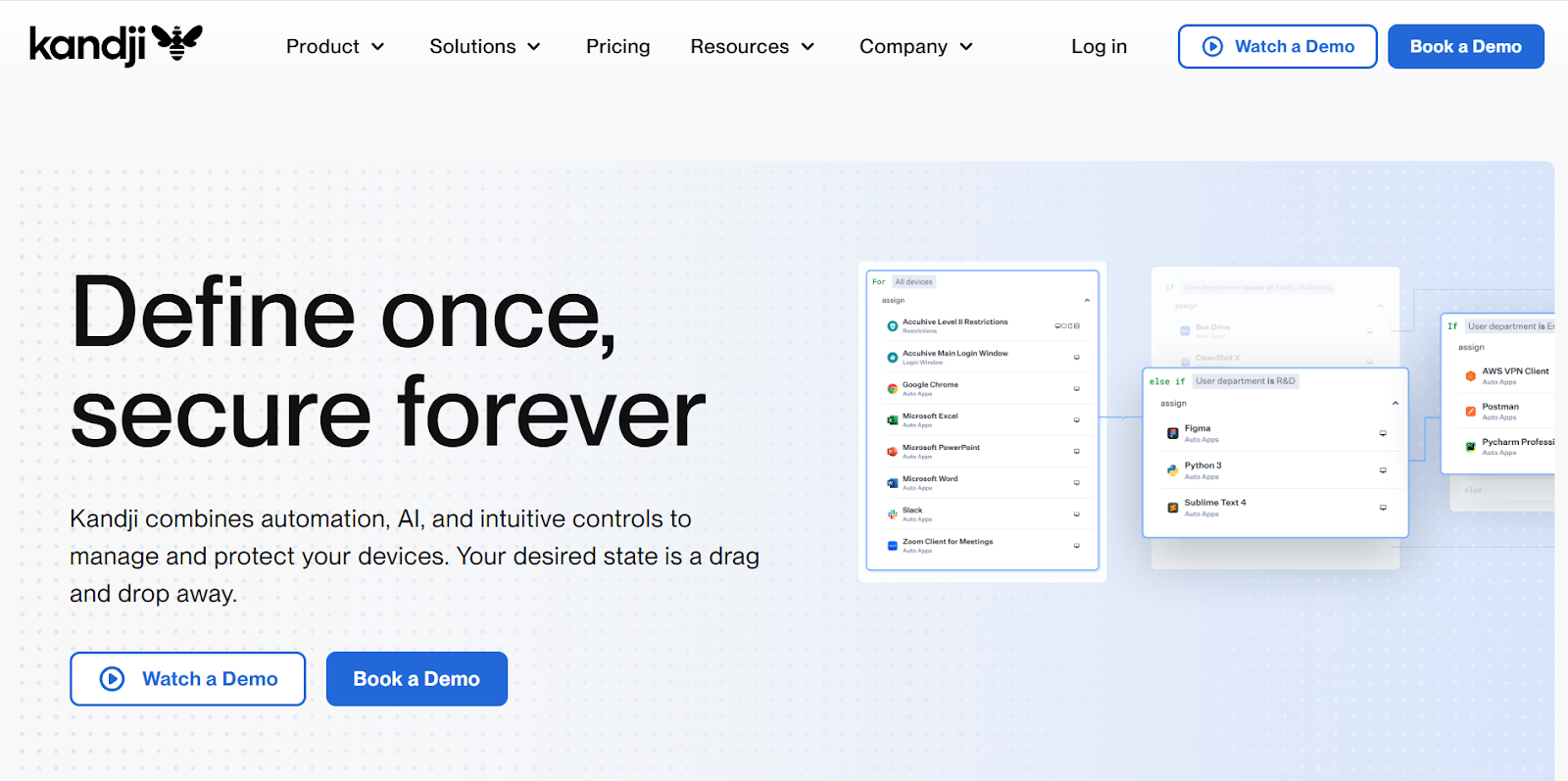
Via Kandji
Kandji is another Apple-only MDM and endpoint security platform with a sleek interface, strong automation, and AI-powered reporting. It combines device management, EDR, and vulnerability management in one place.
The standout feature for IT onboarding is “Auto Apps,” a library of pre-packaged, always-updated software. Along with Kandji’s built-in control library, it eliminates most scripting work and keeps devices patched without extra effort on your part.
Admins praise its simplicity in reviews; they say it offers easy setup, an intuitive UI, as well as quick patching and OS updates.
Kandji’s Liftoff workflow impressed me. It lets you pre-load a branded welcome screen and a list of must-have apps. You assign the policy, ship the Mac, and the rest is automatic: Wi-Fi, FileVault, compliance settings, even custom scripts.
From what I gathered, Kandji focuses on guided setups that walk you through each step so tasks finish faster.
For example, while you can customize which apps or compliance controls get pushed to devices, but you rely on Kandji’s prebuilt templates for most workflows.
Jamf, in contrast, gives you full scripting freedom, like writing custom policies for OS updates or niche security settings, so it’s more flexible but also more complex to manage.
Other cons? Endpoint security is not bundled and must be sourced separately. Some users also report issues with password setups and syncs. Pricing isn’t public either; you’ll need a quote. For cost-sensitive teams, Jamf’s transparent pricing may feel more predictable. Kandji’s automation, while efficient, can feel limiting for large enterprises that demand very specific compliance or security workflows.
Moreover, while tools like Kandji are powerful once the laptop is in the employee’s hands, IT still needs to manage ordering, shipping, returns, and recycling separately.
That’s where Workwize comes in: it covers the entire hardware lifecycle from procurement to deployment, management, and disposal in one platform.
Workwize automatically integrates with MDMs like Kandji or Jamf for software provisioning, while also removing the logistics burden by handling devices end-to-end across 100+ countries so you get the best of both worlds.
Best features
- Live patching support: Always-on patch and vulnerability management that fixes CVEs without extra tooling.
- Zero-touch enrollment: Enroll Apple devices with Automated Device Enrollment for true zero-touch.
- Liftoff workflow: Liftoff guided setup screen displays progress while enforcing compliance before the desktop appears.
Ratings and reviews
Pricing
Custom pricing
4. VMware Workspace ONE UEM
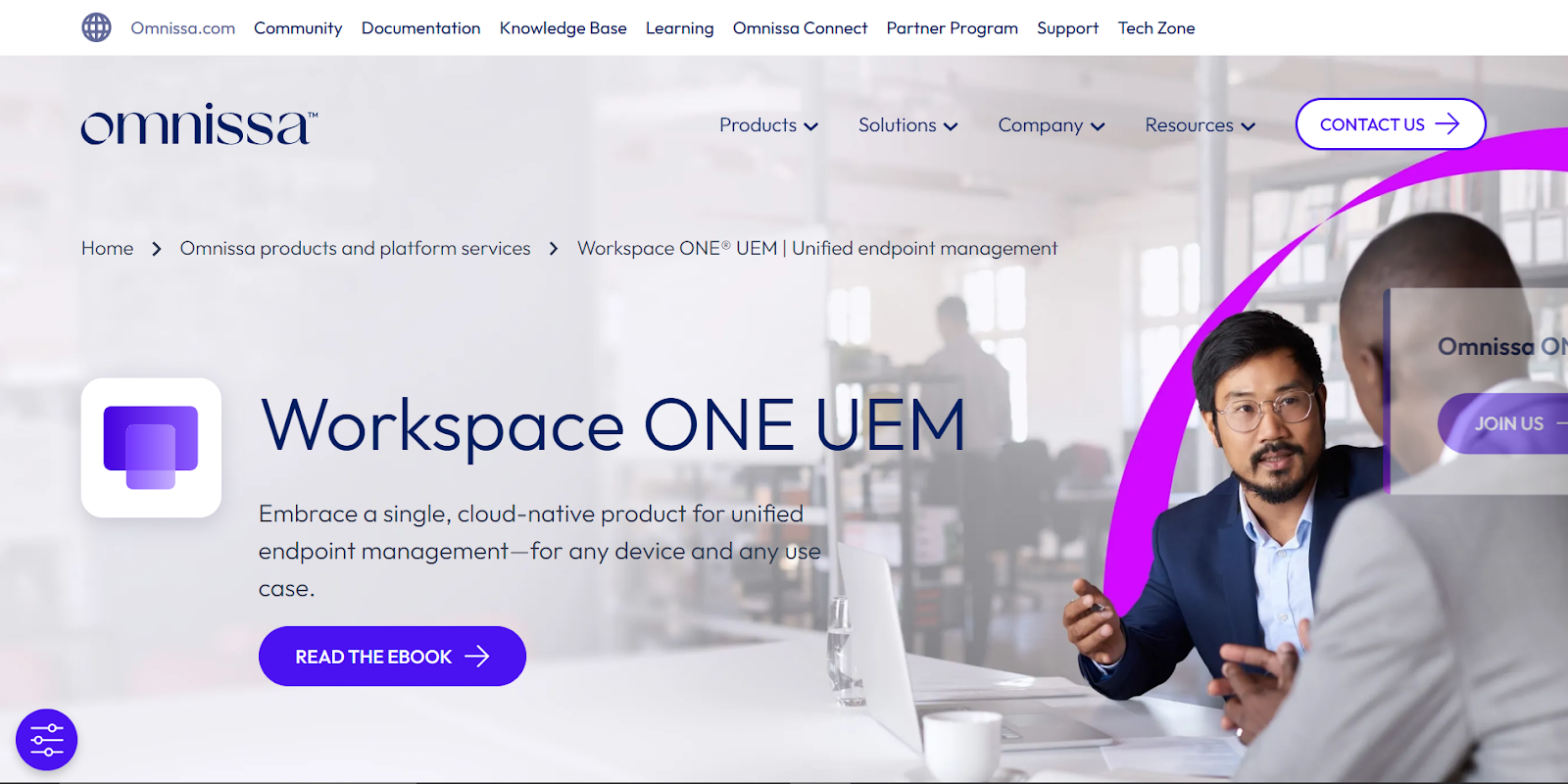
Via Omnissa
Workspace ONE is VMware’s unified endpoint-management and access platform. It combines device lifecycle management, identity services, analytics, and security in a single cloud console that spans every major OS.
From an IT onboarding standpoint, what stood out to me was how the token-based authentication system simplifies onboarding.
Before any equipment is procured, new hires receive a token authentication link. This link directs to the Workspace ONE portal, where they log in and set up their token to begin the out-of-the-box experience
The pricing table is unusually transparent for an enterprise tool, which I obviously appreciated.
During my research, I noticed that Workspace ONE leans on zero-touch deployment, be it through Apple ADE, Windows Autopilot, Android Zero-Touch, or even XR devices. It helps you drop hardware straight on a new hire’s doorstep, already enrolled and policy-compliant.
Policy depth also looked strong (zero-touch onboarding, conditional access, and app lifecycle caught my eye), but from the demos, I could make out that setup required some effort. I’m not the only one; several user reviews mention a real learning curve and heavier initial configuration.
Compared to identity-led options like Okta (which rely on partners for device management), Workspace ONE provides device compliance and access in one place. That coherence is particularly handy when HR is onboarding in batches and laptops come in a mix of Dell, Lenovo, and Mac models.
Best features
- Deliver zero-touch onboarding and install apps at scale through Intelligent Hub
- Offer a unified app catalog with SSO so new hires launch their apps right away
- Enroll Windows devices with Autopilot and Azure AD workflows and apply policies on first login
- G2: 4.0/5 (38 reviews)
- Capterra: 4.6/5 (39 reviews)
Pricing
- Enterprise Edition: $15/user per month
- UEM Essentials: $9.45/user per month
- Desktop Essentials: $7.20/user per month
- Mobile Essentials: $5.40/user per month
5. Allwhere
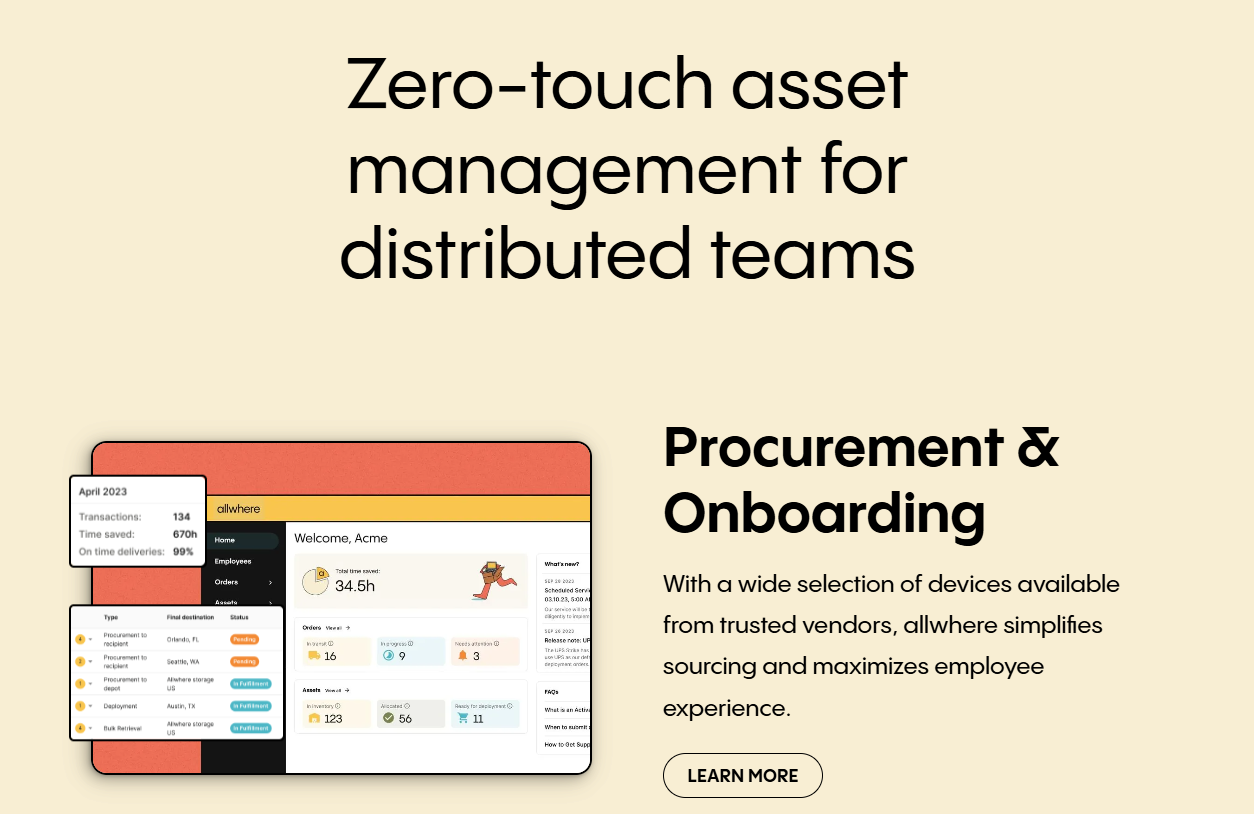
Via Allwhere
Allwhere positions itself as more of an employee experience hub than a pure IT platform. It’s built to simplify remote and hybrid setups by managing stipends, perks, and home-office gear allocation in one place.
You set a budget or predefined kit, employees choose what they need, and Allwhere handles the logistics of delivery, storage, or even retrieval.
What stood out to me is how much it leans into flexibility and autonomy. Employees get the freedom to self-serve within company guidelines, and IT or People teams don’t have to micromanage every step. That approach makes sense for organizations prioritizing culture and convenience.
The trade-off is that Allwhere doesn’t provide the same level of control over the IT lifecycle. It doesn’t handle automated software provisioning, device tracking, or MDM integrations.
Offboarding, compliance, and secure disposal often require separate workflows.
Workwize takes a very different approach. It brings hardware logistics and lifecycle management into a single platform.
Whether it’s Apple, Windows, or Linux laptops, Workwize not only provisions devices through integrations with tools like Jamf or Intune, but also ships them globally, retrieves them when employees leave, and manages repairs or responsible recycling across 100+ countries.
Best features
- Global procurement: Procure devices in bulk from vendors all over the world
- Easy remote onboarding: Configure remote devices from the dashboard and make them ready for work from the first day
- End-to-end logistics: Offload all logistics and employee communication to the platform
Ratings and reviews
- G2: 4.6/5 (8 reviews)
- Capterra: N/A
6. JumpCloud Open Directory Platform
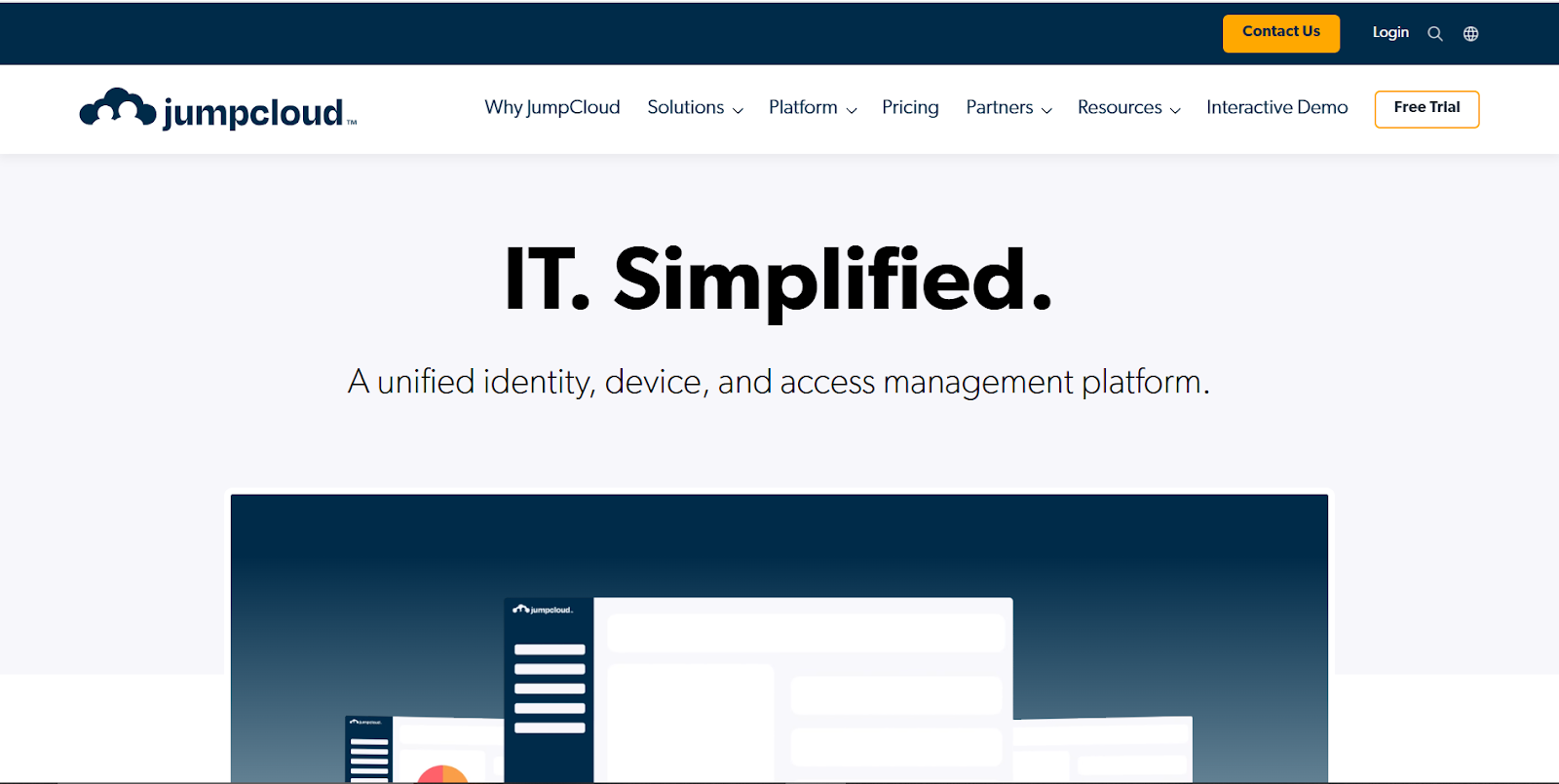
Via JumpCloud
JumpCloud is a cloud-based IT platform that gives you centralized identity, access, and mobile device management. It shines in automating onboarding and offboarding workflows.
But it isn’t a conventional MDM in the Jamf or Kandji sense.
Where those tools specialize in deep Apple management or polished workflows, JumpCloud takes a broader approach: it merges identity, access, and device management into one platform. The same place you enforce Wi-Fi configs or FileVault encryption is where you also create user accounts, apply SSO, and set MFA.
What stood out to me in demos is how it handles onboarding. Once a new hire lands in your HR system, JumpCloud syncs their profile, drops them into the right groups, spins up app accounts, and pushes baseline security policies to their laptop or phone.
That workflow feels simpler than juggling a separate identity platform plus an MDM.
IT admins like the convenience of managing macOS, Windows, Linux, iOS, and Android under one roof. It’s lighter than standing up Workspace ONE or trying to customize Jamf from scratch.
But the trade-offs are real: JumpCloud doesn’t offer the same depth of Apple-specific workflows that Jamf or Kandji provide, and reporting can feel thin for bigger fleets.
Then, JumpCloud’s automation only starts once the device is already with the employee. It won’t help you order laptops, ship them to new hires, or manage global retrievals and recycling.
Workwize fills that gap, acting as the single lifecycle platform that covers procurement, deployment, returns, and disposal in 100+ countries while still plugging into JumpCloud (or any other MDM) for the software side.
Best features
- Centralized SSO and MFA: Get cloud directory, SSO and MFA in one console without any on-premises domain controller.
- Cross-platform device management: Enable cross-OS device policies (Windows, macOS, Linux, iOS, Android) from the same place you manage identities.
- Lifecycle automation: Automate onboarding and offboarding workflows across identity and devices.
Ratings and reviews
Pricing
- Device Management: $9/user per month (billed annually)
- SSO: $11/user per month (billed annually)
- Core Directory: $13/user per month (billed annually)
7. Rippling (IT Cloud)

Via Rippling
Rippling is an IT and HR onboarding platform that connects HR and IT so new hires get everything they need on Day 1.
I saw Rippling in action, and it felt like a unified control panel for IT onboarding. When a new hire comes on board, one can assign and send a preconfigured device right from the dashboard.
It arrives ready with all the required software, security settings, and user permissions.
In other words, like Workwize, Rippling ties shipping and provisioning together so IT doesn’t have to use multiple tools.
What really impressed me is how Rippling handles inventory without manual tracking. I can see every device’s status, whether it’s active, stored, or due for return, all on the same screen. When someone leaves, Rippling sends them a return box with a prepaid label. Once it’s back, Rippling wipes, inspects, and warehouses it.
Best of all, Rippling links onboarding, device delivery, and offboarding into the same workflow. Everything flows from HR to IT to inventory in one place.
But what makes Rippling stand out from most IT tools on this list is its scope. It not only covers HR and IT but also includes finance management, so payroll, benefits, devices, and access all live in the same system.
It’s important to note that Rippling and Workwize both simplify device logistics, but they serve different priorities.
Rippling builds device ordering, shipping, and returns into its broader HR, IT, and finance suite, with regional warehouses and automated return boxes that clean, wipe, and store hardware for reuse.
It works well if you want onboarding tightly tied to payroll and HR data, though details like global warehouse counts or delivery timelines are not publicly disclosed.
Workwize, on the other hand, focuses entirely on hardware lifecycle management. It sources devices, ships from local warehouses in 100+ countries, and commits to 5–7 business day delivery.
It also automates retrieval, reassignment, repairs, and compliant recycling. In short, Rippling integrates hardware into a workforce system, while Workwize delivers end-to-end global lifecycle coverage with deeper reach and transparency.
Best features
- Automate employee onboarding: Kick off onboarding to auto-assign apps, SSO, permissions, and devices
- Manage device security posture from day 1: Get identity and device management together, so SSO and laptop encryption are managed in the same flow
- Customizable workflows: Drag-and-drop workflow builder that maps every Day-1 step, from badge request to Slack channel invite
Pricing
Custom pricing
8. OneLogin
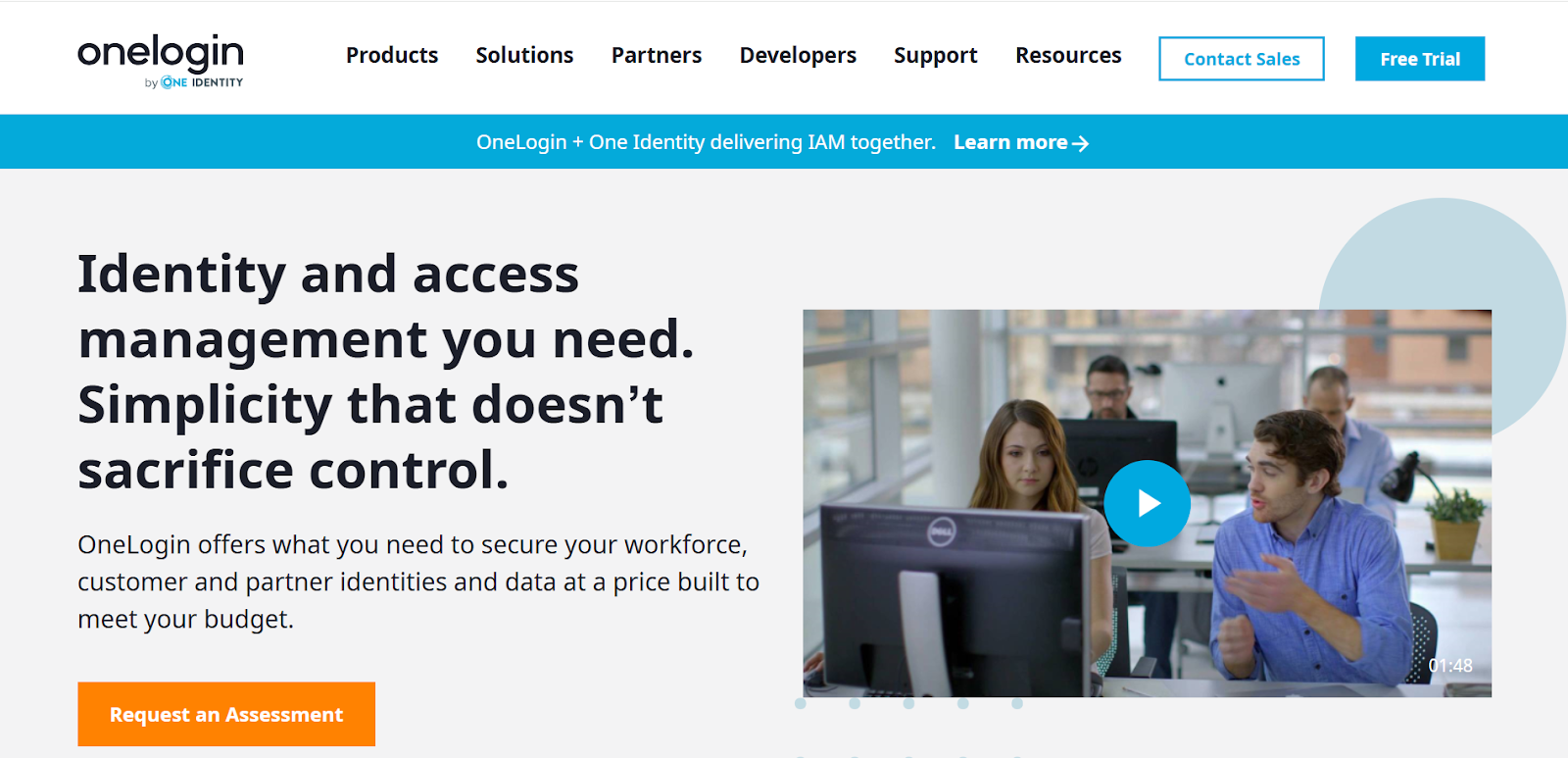
Via OneLogin
OneLogin is a cloud-based identity and access management (IAM) that combines SSO, MFA and user lifecycle management for organizations.
Because it is primarily concerned with app access and authentication, you won’t see the full list of usual onboarding features.
But it handles one of the most essential pillars of onboarding: access and authentication.
It helps with onboarding by automatically creating and assigning accounts for new hires across multiple applications, based on their department, role, and attributes.
New users are onboarded into the OneLogin portal and can immediately access all their apps and tools with a single login, which significantly reduces password fatigue and support requests.
OneLogin has about 6,000+ pre-integrated apps; in practice, that means less fiddling with custom SAML for the usual suspects. If you’re comparing it with Okta, the experience lands similarly, as both prioritize identity-led automation and leave device control to your MDM.
A small caution from recent user comments: a few G2 reviews mention occasional outages and slower support responses. I didn’t hit that in my quick look, but it’s worth noting if you’re a small IT team.
Best features
- Provide one-click SSO to 6,000+ pre-integrated apps
- Automate provisioning and deprovisioning with role-based rules
- Sync users in real time from directories like Active Directory and Workday
Ratings and reviews
- G2: 4.4/5 (280+ reviews)
- Capterra: 4.6/5 (90+ reviews)
Pricing
- Advanced (SSO+MFA): $6/user per month list ($4/user per month bundle)
- Professional: $12/user per month
- Expert: $21/user per month
9. Firstbase

Via Firstbase
Firstbase is a combined platform to handle your IT assets. Like Allwhere, the platform handles global procurement, deployment, management and retrievals in one place.
The focus is on easily equipping employees with the necessary hardware, from laptops and monitors to ergonomic furniture, ensuring a smooth onboarding experience, regardless of the employee's location. And it also manages the entire lifecycle of this equipment, up until retrieval upon offboarding.
Firstbase's onboarding is enhanced by its partnership with Enboarder, an employee communication and workflow platform. Enboarder focuses on creating personalized and engaging onboarding experiences that encourage human connection. It automates communication workflows, sending timely welcome messages, team introductions, and pulse checks to new hires.
I like that the self-service portal is excellently fleshed out here. All new hires select their equipment from a pre-approved catalog and device provisioning is handled automatically.
One of the hiccups you’ll likely face is that you cannot select individual assets for deployment and have to pull from an available pool of inventory. Hopefully, that is addressed with an update.
But how does Firstbase fare against Workwize?
Firstbase goes beyond hardware logistics by layering in employee experience tools. Through its Enboarder partnership, it automates onboarding communications like welcome messages, team introductions, and pulse checks that build early engagement. Its self-service portal also lets new hires pick from a pre-approved catalog, though IT cannot deploy individual devices outside the available pool.
Workwize takes a more infrastructure-first approach. It operates 100+ global warehouses with guaranteed 5–7 day shipping, full lifecycle coverage from procurement to disposal, and integrations with MDMs for automated provisioning.
It also lets you manage products sourced outside of Workwize.
Best features
- Connect with your stack: Integrate with your existing MDM and IDP tools like Jamf, Intune, Kandji, and JumpCloud
- Global logistics: Ship, store, and retrieve across a large country list without your team handling couriers
- Self-service for employees: Get a simple portal and role-based catalogs to reduce IT tickets and make day-one smooth
Ratings and reviews
10. Freshservice (ITSM)
Via Freshservice
Freshservice is Freshworks’ cloud-based IT service-management suite.
The platform lets you manage IT operations, service requests, assets and workflows, and combines ITIL-aligned practices such as incident, change, problem, and asset management with powerful automation and an easy-to-use interface.
As for onboarding, there’s a lot here. You get a unified service catalog and a self-service portal where new hires can easily request IT services, software, and hardware needed for their roles.
Since ticketing is at the heart of the platform, you can automate onboarding processes with no-code workflows to route tickets, approve requests, and trigger asset assignments.
I like that you can track IT assets allocated during onboarding in detail. This means that devices and software licenses are properly assigned, monitored, and maintained throughout an employee’s lifecycle.
However, be prepared to hit a wall if you work with very complex and large-scale onboarding workflows. Workflow customization and depth are not its strongest muscles.
Best features
- Automated workflow and ticketing: Automate processes with no-code workflows to route tickets, approve requests, and trigger asset assignments and speed up onboarding
- Self-service portal: Get a self-service portal where new hires can easily request IT services, software, and hardware
- Omnichannel support and knowledge base: New employees can access help through various channels (email, chat, portal) and consult a centralized knowledge base
Ratings and reviews
Pricing
- Starter: $19/agent per month (annual)
- Growth: $49/agent per month (annual)
- Pro: $99/agent per month (annual)
- Enterprise: custom pricing
- Business Agent add-on (Pro and Enterprise): $49/agent per month.
11. Jira Service Management (Atlassian)
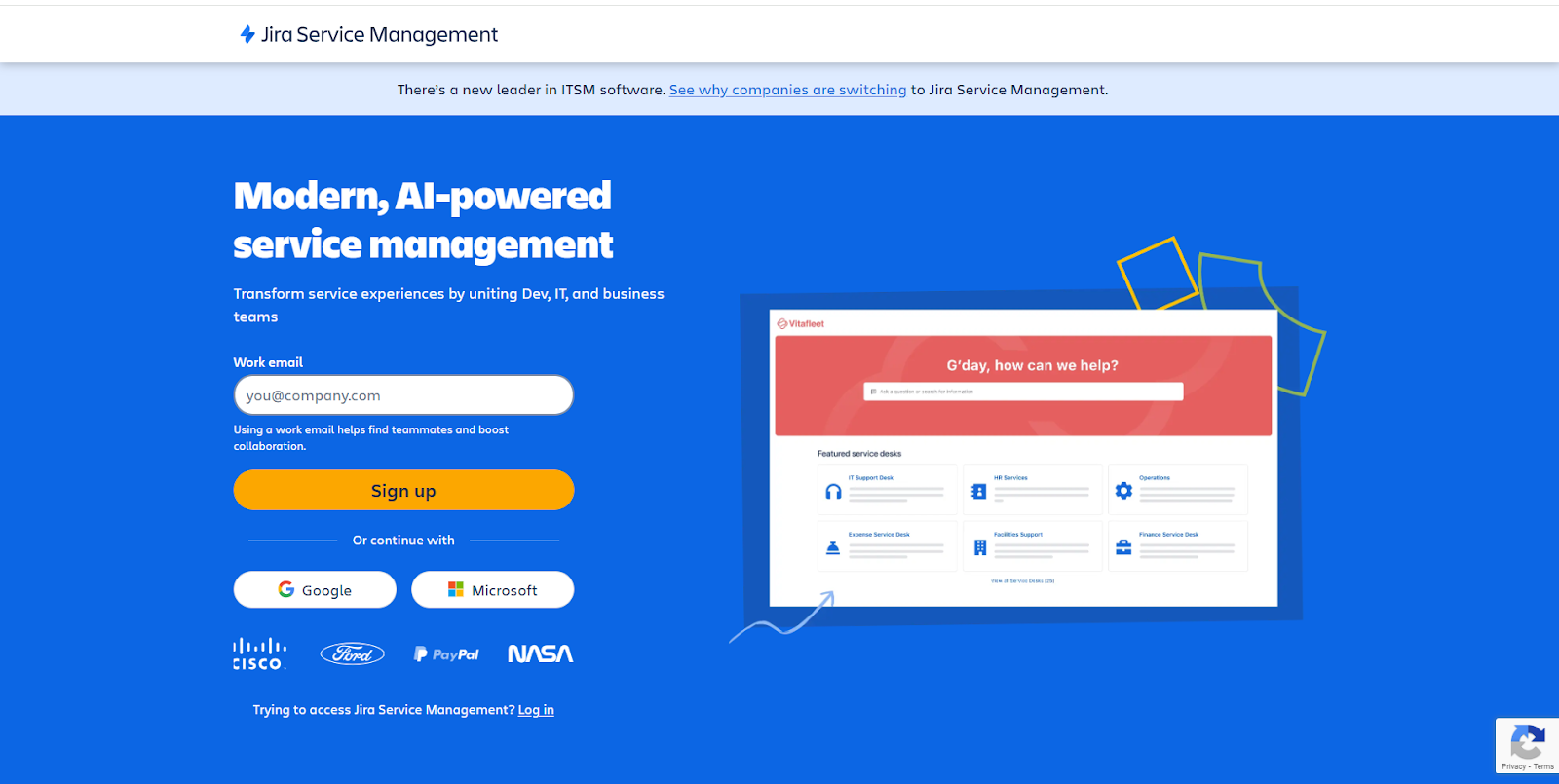
Jira Service Management (JSM) is Atlassian's IT service management (ITSM) platform built on the Jira software foundation. It enables IT, development, and business teams to manage and deliver high-velocity service experiences collaboratively.
If your company already works with Atlassian, onboarding flows feel right at home.
New hires can submit onboarding requests (hardware, software access, permissions) through a user-friendly Atlassian portal, which centralizes all onboarding tasks into one platform.
You can also configure onboarding flows to route requests automatically to relevant teams, trigger approvals, assign tasks, and provision resources.
This has a big positive impact on accelerating new employee setup.
The collaboration between IT, HR, and other stakeholders in a shared workspace is often underrated, and I only recently became aware of its significance. However, it really helps communication and alignment throughout the onboarding process.
Compared with Freshservice, JSM wins if you want tickets, changes, and dev issues in one platform and your teams already use Jira. However, the complexity might be daunting…might even feel like getting smacked in the head with an encyclopedia.
Best features
- Service request management: Submit onboarding requests through a user-friendly self-service portal
- Asset and configuration management: JSM keeps track of onboarding assets allocated to new employees and manages configuration dependencies
- SLA and performance tracking: IT teams can define SLAs for onboarding-related requests to ensure timely execution and monitor workflow efficiency
Ratings and reviews
Pricing
- Free: $0 (up to 3 agents)
- Standard: $19.04/agent per month
- Premium: $47.82/agent per month
- Enterprise: custom pricing.
Buyer’s Guide: How to Choose an IT Onboarding Platform
I have given you the choices. Now, I feel like it’s also my duty to tell you how to choose.
With so many options available, it’s easy to pick the wrong platform and suffer the consequences of that for years.
1. Start with your day-1 checklist
You ideally need a one-page list you can use on onboarding day. It should list how you create IDP accounts, groups, and enroll MFA. Let me share a mini checklist we use for your inspiration:
 Create the user in your IDP and add the right groups
Create the user in your IDP and add the right groups  Set up MFA and verify recovery options
Set up MFA and verify recovery options Issue a temporary password or magic link
Issue a temporary password or magic link  Enroll the laptop or phone in MDM
Enroll the laptop or phone in MDM  Push required OS updates and patches
Push required OS updates and patches Assign email, calendar, and chat
Assign email, calendar, and chat Auto-provision core apps (e.g., CRM, code repo, design, support) via SCIM
Auto-provision core apps (e.g., CRM, code repo, design, support) via SCIM  Set up VPN or ZTNA and test access
Set up VPN or ZTNA and test access Add to shared drives, folders, and project spaces
Add to shared drives, folders, and project spaces Invite to the new-hire portal and share policies and the handbook
Invite to the new-hire portal and share policies and the handbook Collect tax forms and e-signatures
Collect tax forms and e-signatures  Record approvals and create an audit trail
Record approvals and create an audit trail
This checklist is important because it will clarify your expectations when you shortlist your tools and tell you what features to look for.
2. Map every task to four pillars
Next, tie each line to a system so nothing slips. Identity covers SSO, MFA, and groups.
Device management covers enrollment, patches, and compliance. SaaS management covers license assignment and SCIM provisioning. People operations covers the HR records and documents.
Now comes the most important step.
3. Decide what kind of tool you want
Before you shortlist tools, pick your path. Do you want one platform for everything, or a stack of best-of-breed tools wired together?
An all-in-one platform handles procurement, device setup, shipping, MDM hooks, and returns in one place. It’s one vendor, one dashboard, one bill.
The upside is speed. Setup is quicker, there are fewer handoffs, and day one is easier to run. But you lose depth and flexibility. You may get fewer advanced features in some areas, and it’s harder to swap pieces later.
A build-your-own stack uses HRIS, IDP, MDM, and SaaS management. You choose the best tool for each and connect them.
The advantage is control. You get deeper features and can replace parts as your needs change. However, it takes more effort and you’ll spend more time on integrations, testing, and keeping audit trails consistent.
4. Pick a control plane and verify integrations
Now you have to choose where you trigger onboarding: HRIS or IDP.
Many teams are triggered from HRIS (hire date creates the user), while others are triggered from the IDP. Either way, confirm three things:
- Your HRIS sync is real-time or close.
- SSO and SCIM exist for at least your top 15 apps.
- Device coverage matches your fleet, including OS updates and compliance checks.
Note that with all-in-one tools, you’ll most probably won’t have to worry about this step.
5. Run a two-week pilot and measure it
After the onboarding flow is mapped out, pick a small cohort (new hires or test users) and run the full cycle on 2 or 3 separate platforms. Track time-to-ready (from HR create to first login), error rate (failed provisions, manual fixes), and steps automated (count the clicks you didn’t do).
Ultimately, pick the tool that shortens setup, reduces errors, and cleans up offboarding.
Make IT Onboarding Simple With Workwize
The 11 IT onboarding platforms we explored highlight just how much the right tool can streamline processes, reduce manual effort, and improve employee experiences from day one.
From automation and security to integration and scalability, each solution has its own strengths depending on your organization’s priorities.
But if you’re looking for a platform that goes beyond the basics, bringing IT onboarding, device procurement, and lifecycle management together in one place, Workwize offers a modern, scalable approach that grows with your team.
It helps you not just track or manage processes but actually puts devices to your employees’ hands and back.
Schedule a Workwize demo now to learn more.
FAQs
1. How should we onboard contractors or interns?
Create a separate access path. Use contractor groups, time-bound accounts, and auto-expire dates.
Most importantly, limit access to only the apps and data they need. Block local admin, require MFA, and log every grant and removal. When the contract ends, run the same-day offboarding that you use for employees.
2. Can we support BYOD without risking data?
Yes, just treat personal devices differently. Use app-level management (work profiles on Android, user enrollment on iOS) so you control company data, not the whole phone.
Also, enforce MFA and device posture checks before sign-in. Offer web-only access for high-risk tools if a device fails checks.
3. How do we ship and track hardware for remote hires?
For remote devices, pre-register them with your MDM so they enroll on first boot. Tag every laptop, record the serial, and link it to the user before shipping. Track delivery, confirm enrollment, and capture a quick photo or receipt as proof of custody.
About the authors:
Simplify IT operations with Workwize
Learn how Workwize makes IT asset management easier and more efficient. Schedule a custom demo today and see the difference.
Recent articles
8 Virtual Onboarding Best Practices for IT Teams
With hybrid workforces becoming a global standard, gone are the days when you set up a...
The Only IT Onboarding Strategy Modern Organizations Need
Effective onboarding can increase new hire retention by up to 82%.
8 Key Steps to Automate the New Employee Onboarding Process
If you’re part of an HR or IT team, you know new employee onboarding is tough.
Ready to optimize your remote on- and offboardings?
Let’s schedule a short chat and see how we can help!










